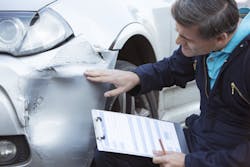It goes without saying that vehicle repairs are getting more complex. The more complex the repair, the more we have to understand the repair process and the need to document each one as detailed as possible to ensure compliance. I was talking with a shop manager yesterday about an inner center pillar replacement that ended up being more complex than entering a line on a damage appraisal to “replace inner center pillar.” A review of the repair procedures showed that the inner center pillar replacement could only be performed once the roof and uni-side were removed, which totally changed the dynamics of the repair.
It is not just the structural repairs that require procedure reviews. I was performing a damage appraisal review on a Chevrolet Camaro that had damage to the rear bumper and reinforcement. I suggested that even though the damage was minor, we should follow the General Motors (GM) guidelines and validate the need to inspect the steering column. By reading the GM bulletin, we learned that not only did the steering column require inspection, but the steering wheel had to be inspected as well.
Ford offers three pages of instructions on how to properly install a front door outer panel. Within the instructions it specifies the proper rivets, metal bonding adhesive, seam sealer, flutter bonding adhesive, cavity wax application and proper sound deadening pad placement. Documenting the repair steps as the instructions dictate is important, as it ensures all involved understand the repair process. Simply writing “corrosion protection” or “seam sealer” at the bottom of an appraisal will not satisfy a reviewer that the procedure was followed correctly.
I was once told by an industry leader that to understand what a vehicle went through in a collision, you should scan, measure, and check the wheel alignment prior to documenting any damage. That made sense to me, as it helps discover damage that you cannot see. A recent MOPAR statement recommends identifying all structural distortion through the use of a three-dimensional measuring system. I have seen situations in shops where technicians were trying to line up body panels without success. When asked if they had measured the vehicle, a common reply was that “it didn’t look that bad.” Critical misalignment cannot always be seen, and following the procedure above would prevent trial and error installation attempts while validating structural integrity.
I would not be doing my job if I failed to mention refinish repair processes. An example of one that is not always followed is the use of a ground coat. Many manufacturers use a tinted primer during the factory paint application, which must be replicated when refinishing. Most paint manufacturers will recommend a tinted sealer or undercoat to match the factory-applied tinted primer. Understanding the need for this and documenting the requirement will reduce frustration during subsequent color matching processes.
Another refinishing process that is commonly missed is testing the primer on plastic bumpers to verify it is insoluble. This is a simple test using a process specified in the paint manufacturer’s primed bumper preparation procedure. It should be performed on any bumper that is not identified as raw plastic and documented on the damage appraisal. Understanding the need for this process will eliminate paint adhesion problems before they can start.
A third-party payer’s insistence on reducing base coat on repaired panels brings its own unique challenges. The refinish process for base coat reduction is not clearly defined but understanding the blend panel procedure lends some assistance. The base coat refinish procedures are written to apply base to an entire panel. When base coat is only partially applied, blend procedures must be followed to prevent paint concerns. Within the blend panel refinish procedures, it specifies in most cases that a wet bed must be applied to allow the base coat to flow into the existing finish and ensure an unnoticeable transition.
Understanding the repair processes defined by the vehicle manufacturers and your paint supplier are vital to performing a complete repair. Estimating databases are getting better every day and offer repair process notes to guide the appraiser on required steps. However, they have not reached the point of duplicating OEM repair procedures nor provide instruction on paint refinish processes. Develop the habit today of performing complete research and thorough documentation, and tomorrow you’ll begin reaping great dividends that you never expected.



